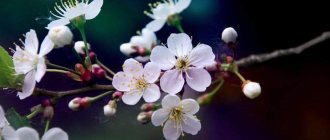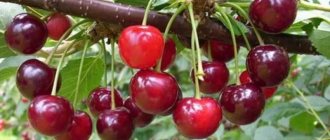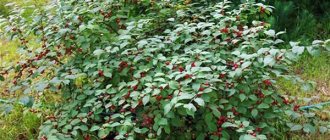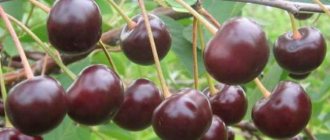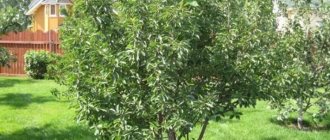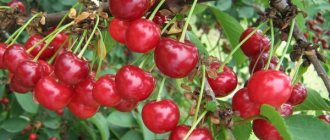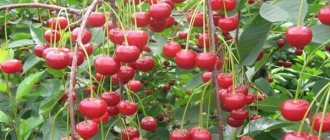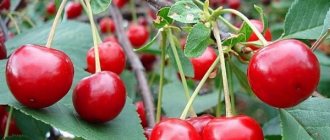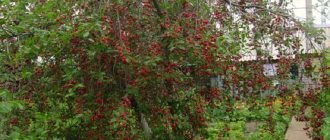History of selection
Morozovka belongs to the cherry varieties obtained by Russian breeders. The originator of the variety was breeder T. Morozova in the 80s of the last century.
This cherry variety was created for temperate climates. Morozovka was obtained by crossing the cherry varieties Lyubskaya and Vladimirskaya.
Lyubskaya cherries have tasty and large berries, and the variety is resistant to diseases. Vladimir cherry is frost-resistant. The new cherry variety Morozovka has acquired stable characteristics of its parents.
Resistance to drought and frost
The Morozovka dessert cherry variety has become a favorite of breeders and scientists, since the berry has many positive aspects and is also resistant to coccomycosis, which infected all plants of the USSR. The fruits of the Morozovka cherry can develop well in unfavorable conditions, so cherries can often be found in various areas of farmers and gardeners.
During the whole summer, when the cherry tree is growing, it can be watered only a few times, since it has a very high resistance to drought. Due to its high winter hardiness, the variety can be grown in areas where the climate is temperate or cool, and the berries will be as tasty as in the south. If you read reviews from gardeners, you will find out that only in very severe frosts in the summer can a flower bud freeze, but at the same time the tree trunk will feel great.
Morozovka cherry: photo of the variety
Description of Morozovka cherries
Appearance of Morozovka cherry variety:
- Tree. Low or medium height, reaches a height of 2-2.5 m.
- Crown . Wide, raised.
- Escapes . Large, grey-green. A small number of lentils form on them. Buds form on the shoots.
- Leaves. Oval in shape, dark green in color, with a glossy plate, with slight redness at the base.
- Fruit. Dark red, no covering spots. The weight of the berries is 4-5 g. The pulp is dense, the taste is sweet and sour. The skin is dense, elastic, not prone to cracking.
- Flowers. Large, have rounded white petals.
Chemical composition of berries:
- sugars - 10.5%;
- acids - 1.37%;
- ascorbic acid - 30 mg/100 g.
Advantages and disadvantages
The ordinary Morozovka cherry has a huge number of positive aspects, but despite this there are also negative features.
Pros:
- The variety has a stable and regular harvest.
- The berries have a wonderful sweet taste and pleasant aroma.
- The cherry tree is small in size, so it takes up space.
- The compactness of the tree will allow you to harvest faster.
- The variety is resistant to drought and frost.
- Even with a massive attack of coccomycosis, the plant will not become infected with it, since it has very strong protection against this disease.
- Morozovka cherry can be grown as a columnar crop.
- Fast ripening period, the crop has time to ripen even in areas with cold climates, without encountering late frosts.
- Due to the thick skin, the fruit can be harvested mechanically.
- Morozovka cherry variety will bloom and produce a high yield even in unfavorable conditions.
- When fully ripe, the seed comes away beautifully from the flesh of the berry.
Minuses:
- The variety is sterile and will not produce a harvest without other varieties.
- In areas where there is severe frost in winter, the buds may freeze.
- The berries are easily separated from the fruit stem, so they can fall off in strong winds.
Characteristics of the variety
Morozovka cherry is a hybrid and is considered one of the best varieties of domestic selection. Juicy berries, high resistance to adverse weather conditions and diseases, allow it to be grown both on farms and in private gardens.
Winter hardiness and drought resistance
Even in the hot summer, you can water it several times a season - the Morozovka variety has high drought resistance.
Good winter hardiness allows the crop to be grown in areas with temperate and cool climates. The variety withstands low temperatures well.
Flower buds can freeze only in the north of the Black Earth Region.
Pollination
A characteristic feature of the Morozovka cherry is its inability to fertilize by self-pollinating its flowers. In order for the crop to develop and bear fruit normally, it is necessary to plant self-fertile cherries in close proximity to it.
The best pollinator varieties:
- Griot Michurinsky;
- Lebedyansky;
- Zhukovsky;
- Vladimirsky;
- Turgenevsky.
Without pollinators, the Morozovka cherry blossoms, but does not form ovaries.
Flowering period and ripening time
Cherry blossoms in April. The berries ripen in July, sometimes a little earlier, depending on the climate and weather. The tree bears fruit 3-4 years after planting.
Productivity and fruiting
The crop produces high yields in the presence of properly selected pollinators. More than 35 kg are collected from one tree.
Area of use of berries
Application of Morozovka cherries:
- freezing;
- pies;
- sauces;
- compotes;
- jelly;
- jam;
- syrups.
Resistance to diseases and pests
Resistance to diseases is increased, especially in relation to coccomycosis. Even with massive damage to other plants, cherries are not infected. The variety has an average level of resistance to insects and their attacks.
Harvest: collection and storage
To extend the shelf life of the crop, cherries are collected together with the stalks. If harvested in sunny, dry weather, the fruits will remain in the refrigerator without loss of taste and quality for at least 2 weeks. The berries can also be frozen along with the seeds, which will allow them to be stored for up to 6 months. At the same time, cherries do not lose either taste or sweetness, and also remain beneficial for the body. Morozovka is considered a dessert variety and is perfect for both fresh consumption and for making juices, jams and preserves.
Berries collected together with the stalks are stored longer
Advantages and disadvantages
The advantages of the variety include the following qualities:
- precocity;
- precociousness;
- stable fruiting;
- excellent taste and appearance of the fruit;
- frost resistance (tolerates frosts down to -27 degrees);
- low maintenance requirements.
The disadvantages include:
- early flowering, so in the northern regions the buds may be damaged by spring frosts;
- self-sterility of the tree.
Planting Morozovka cherries
For Morozovka, the choice of planting site is very important. One or two year old grafted trees are usually planted. The seedlings are not too demanding, but prefer fertile soil with sufficient drainage, which protects the tree roots from waterlogging during the rainy season.
Timing and choice of landing site
Planting can be done in the spring, in the second half of March, or in the fall - in early September. During this period, the plant will not be exposed to frost and drought, thanks to which it will be able to take root better.
When choosing a place for young cherries, you should give preference to the southern or southwestern part of the garden. The area should be well lit and protected from the wind. An excellent solution would be the sunny side, 1.5-2 m from a low fence.
The groundwater level in the area should not be higher than 1.5 m so that the roots can develop freely. Cherry prefers loamy, sandy loam and sandy soils with neutral acidity (pH 6-6.5).
Good and bad neighbors
Next to the cherry you can plant the following crops:
- cherries;
- plum;
- elder;
- honeysuckle;
- grape.
When the cherry tree enters the fruiting period and takes root well, ground cover plants can be planted under it. They will protect the root from overheating and retain moisture.
Cherry does not tolerate proximity to:
- sea buckthorn;
- raspberries;
- blackberries;
- black currant;
- gooseberries;
- peach;
- red rowan.
Selection and preparation of planting material
You should not buy seedlings from others. It is better to buy them from nurseries or trusted garden centers. One-year cherries with a height of about 80 cm and two-year seedlings up to 1.1 m take root well.
It is better to choose seedlings with the following characteristics:
- height from 70 to 110 cm;
- root length at least 15 cm;
- the surface of the branches and trunk is without damage;
- light brown bark;
- the root is well developed.
Before planting, the seedling is soaked in water for several hours. If you bought a tree with an open root system that was not protected by film or a clay mash, dip it in water for a day, adding root (1 g per 1 liter of water).
Landing
The procedure for planting a seedling is very simple:
- Make a hole at least 0.5 m deep and wide.
- If more than one tree is being planted, then leave a distance of 2.5-3 m between the holes.
- In the central part of the hole, form a slide 15 cm high, into which place a peg.
- Place the seedling in the hole, spreading the root system over the hill.
- Cover with soil and compact.
- At a distance of about 30 cm, dig a ring hole and fill it with water (30 liters per seedling).
- When the liquid is absorbed, cover the tree trunk with mulch and tie the tree to a stake.
Planting and care
For the good development of the plant throughout its life, it is extremely important to choose the right place to plant the seedling.
The right place for Morozovka is highly fertile soil that easily absorbs moisture and is well ventilated (but without cold drafts). Of course, it must be well illuminated by sunlight.
Normal propagation of Morozovka occurs through
cuttings and budding. The rooting rate of green cuttings is about 70%.
Seedlings are harvested in the fall, but they are planted in the spring. Preference is given to soils with neutral acidity. The young plant takes root well on sandy, sandy loam and loam soils.
Having chosen the soil suitable for planting, you should also think about the correct distribution of seedlings in the garden plot. In order for trees to develop fully, it is necessary to maintain a distance between them ranging from 2.5 to 3.5 m .
Then planting holes are formed. Each such hole should have a diameter of 50-60 cm and a depth of 40-50 cm . The soil extracted during excavation is mixed with manure (humus), a small amount of potassium chloride, ash, superphosphate . 1-1.5 buckets of ordinary sand to it
Having installed the seedling in the hole, dig in its trunk and compact the soil around the trunk. within a radius of 20-30 cm from the trunk . 2-3 buckets of non-cold, settled water are poured into the funnel created in this way
The soil that has sagged after watering is mulched with a mixture of humus and sawdust. For a good effect, the layer of mulch, which protects the soil from drying out, should be at least 2-3 cm thick.
Caring for Morozovka cherries
Morozovka is considered an unpretentious cherry variety, but proper care will help the tree produce a bountiful and tasty harvest.
Watering
For normal fruiting, cherries should be watered 4-6 times per season. The irrigation rate is 40-70 liters of water per tree (large quantities for mature trees).
Watering is done during the following periods:
- end of flowering;
- formation of the ovary;
- end of harvest;
- preparation for winter (no later than mid-October).
The last watering is intended to deeply saturate the soil with moisture. It is advisable to supply water by drip, but you can also use sprinkling or irrigation along temporary circular furrows.
Feeding
The quality of the harvest directly depends on fertilizing. For the first 7 years, cherries must be fertilized annually. Further, certain intervals are observed between feedings. Mineral fertilizers are applied every 2 years, and organic components - once every 4 years.
Feeding Morozovka cherries:
- Before flowering, cherries are sprayed with urea (20-30 g per 10 liters of water) or root feeding is carried out with ammonium nitrate (15-20 g per 1 sq. m of trunk circle).
- During flowering, root feeding is carried out with the following solution - 5 liters of mullein and 10 cups of ash per 50 liters of water. A tree requires 1 bucket of fertilizer.
- 2 weeks after the second feeding, phosphorus-potassium fertilizer is applied - 1 tbsp is taken per 10 liters of water. l. potassium sulfate, 1.5 cups of superphosphate. For 1 sq. m - one bucket of solution.
Additionally, manure or compost is added during the winter to protect the root part of the tree from frost.
Soil care
It is recommended to regularly loosen the soil under the tree to get rid of weeds and ensure good soil aeration. Loosening is carried out after watering, when the soil dries out a little, in order to destroy the soil crust. The processing depth is 10-15 cm (smaller depth is near the trunk).
From 5-6 years after planting, you can sow the row spacing with a lawn mixture. In this case, you can refuse to loosen the soil, but the grass should be mowed regularly and left as mulch.
Pruning and crown formation
This cherry variety requires regular pruning - sanitary and crown-forming. The branches are removed with a sharp sterile instrument, and the sections are treated with 3-4 layers of oil paint or garden varnish to prevent infection of the trunk.
Tree trimming diagram:
- In the year of planting, the top of the cherry seedling is cut off by 10-15 cm.
- In the second year, all the side shoots located on the trunk are cut out from the seedling, except for the three most developed ones.
- In the third year, two or three well-developed shoots of the third order are left on each of the main lateral branches.
- By the fourth year, the crown of the cherry tree is formed, so only the annual growth of branches is removed.
- In all subsequent years, pruning can be used to adjust the height of the tree and the length of the main branches.
In addition to formative pruning, the tree needs sanitary pruning. It is held in October. Remove all dry and damaged branches so that in the spring the tree wakes up from hibernation faster.
For mature plants, rejuvenating pruning is necessary. It is carried out from 10-12 years of cherry life. If new growths per year do not reach 15 cm, and the skeletal branches are exposed at the base, the tree is pruned into three-year-old branches, shortening them by 25-30%.
To rejuvenate the cherry, you can trim 50-60 cm of the main conductor, which will lead to lightening of the crown and the formation of new side shoots.
Preparing for winter
The crop easily tolerates the winters of central Russia, but the trees require certain preparatory measures.
To ensure that cherries overwinter successfully:
- Clear the soil under the tree of weeds, fruits, leaves and branches.
- Dig up the tree trunk circle.
- Mulch the roots of the tree with sawdust or peat in a 15 cm layer. Remove the mulch in the spring so as not to overheat the roots.
- Whiten the trunk and a third of the branches of the first tier with a solution of 1 kg of lime, 500 g of powdered clay and 200 g of copper sulfate. For mature trees, dilute the mixture in 5-7 liters of water, for young seedlings up to 5 years old - in 10-14 liters of water.
- Cover young trees with burlap or spruce branches.
- In winter, shovel the fallen snow under the tree with a high (40 cm) snowdrift.
Diseases and pests
The main diseases of Morozovka cherries:
- Clusterosporiasis or perforated spot. A fungal disease in which brown and brown spots appear on the leaves. Dead tissue crumbles, leaving through holes. All affected parts are removed and burned (this is especially important to do in the fall before wintering the cherries); the trees are treated with 3% Bordeaux mixture.
- Coccomycosis . Reddish dots appear on the leaves, which increase over time, turning into spots. A pinkish coating is visible on the back of the spots. Treatments are carried out with 3% Bordeaux mixture, and after flowering they are sprayed with copper oxychloride.
- Anthracnose .
Dull spots appear on the fruits, in place of which bumps appear. Over time, the cherries dry out. Before flowering begins, spray with the drug "Oxyx" (10 liters of water per 40-80 g of product). - Rust . The outer side of the leaf blades is covered with orange or brown swellings. Spraying is carried out, before the formation of flowers and after this stage, with copper oxychloride (40 g per 5 liters of water, consumption of 4 liters of solution per tree).
It is necessary to pay serious attention to pests that damage trees and crops:
- Cherry aphid. Signs: leaves curl, black dots appear on the reverse side - these are aphid colonies. Against the pest, it is good to spray the foliage with a soap solution (1/2 piece of laundry soap per 10 liters of water). You can use chemicals like “Iskra” (dilute 1 tablet per 10 liters of water, spray the affected areas).
- Slimy sawfly . The pest lays eggs on the back of the leaves. The leaves themselves look burnt in appearance. Use Fitoverm or Aktara (4 g per 10 liters of water). Spray once before or after flowering.
- Cherry weevil. The reddish-bronze beetles eat the buds and buds, and the larvae chew the leaves. After flowering, treatment is carried out with Karbofos (35 g per 5 liters of water), again after 7-8 days.
- Hawthorn. The food of butterfly caterpillars is buds and leaves. Caterpillars overwinter in nests made of dry leaves, fastened with cobwebs. It helps against the pest by spraying the tree and the tree trunk in early spring with a solution - 500 g of urea and 100 g of copper sulfate per 10 liters of water.
Protection from birds and rodents
Saves from rodents damaging the bark and lower shoots of the tree:
- Wrapping the trunk with a special mesh or any other dense material.
- At the beginning of the season and before winter, the tree trunk is coated with whitewash. This scares away animals and prevents them from feeding on the bark.
Birds eat up part of the crop, so they need to be scared away. Effective means of protection against feathered pests are:
- Cellophane bags that are tied to branches. They scare away birds by rustling (you can use foil instead of bags).
- Cassette film. Tied to branches.
- Nets that completely cover the tree crown along with the fruits.
- Special repellent devices that create low-frequency sounds.
With proper planting and compliance with all care standards, Morozovka cherries will delight you with an abundant harvest of tasty and healthy berries. High resistance to adverse natural conditions makes the crop popular among gardeners and farmers.
1
0
Copy link
Moniliosis
Leaves with this disease look as if they were burned and subsequently rot. The berries are covered with spores. The soil and plant are treated with Bordeaux mixture. Horus and Fundazol will also be useful.
In addition to diseases, you should be wary of insects. The first representative is aphids. Leaves and shoots are susceptible to attack. Aphids are dragged onto the tree by ants, which can be eliminated with garlic tincture. Flies can hide in the ground for the winter. Their larvae gain access to the ovary, and then a worm forms inside it. There are certain ways to fight. Fallen berries are removed from the ground, and the area where the tree is planted is dug up. The loosened soil will freeze in winter and the flies will die. Use simple methods whenever possible, without involving chemicals.
